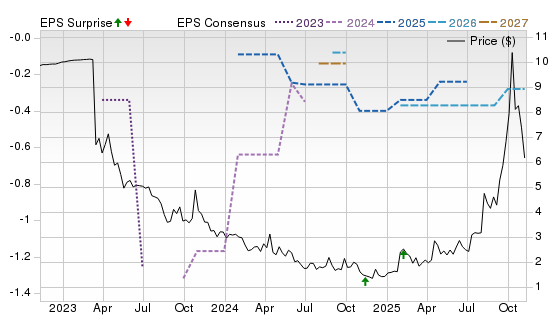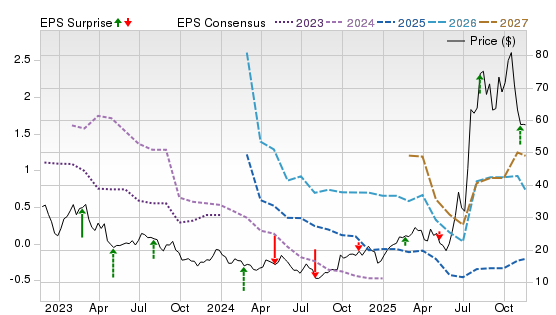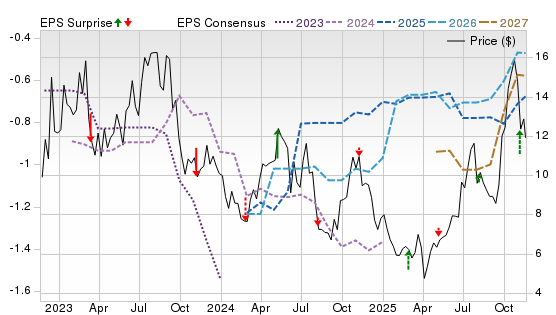Top 5 Best Rare Earth Stocks to Buy Today
| Company (Ticker) | 12 Week Price Change | Forward PE | Price | Proj EPS Growth (1 Year) | Projected Sales Growth (1Y) |
|---|---|---|---|---|---|
| Uranium Royalty (UROY) | 18.48% | 1,077.00 | $3.48 | 111.11% | 195.30% |
| NioCorp Developments Ltd. (NB) | 31.53% | NA | $5.58 | 20.00% | NA |
| Albemarle (ALB) | 43.34% | NA | $117.38 | 47.12% | -5.83% |
| MP Materials (MP) | -10.99% | NA | $58.87 | 52.84% | 13.66% |
| Ivanhoe Electric Inc. (IE) | 43.05% | NA | $12.44 | 51.61% | 22.95% |
*Updated on November 20, 2025.
Uranium Royalty (UROY)
$3.48 USD -0.11 (-3.06%)
3-Year Stock Price Performance

Premium Research for UROY
- Zacks Rank
 Strong Buy 1
Strong Buy 1
- Style Scores
F Value D Growth F Momentum F VGM
- Market Cap:$491.15M (Small Cap)
- Projected EPS Growth:100.00%
- Last Quarter EPS Growth: 200.00%
- Last EPS Surprise:200.00%
- Next EPS Report date:Dec. 11, 2025
Our Take:
Uranium Royalty Corp. is a pure-play royalty and streaming company offering indirect exposure to uranium prices, including a sizeable physical U₃O₈ inventory, a structure that keeps operating risk off project balance sheets while preserving upside to a tightening fuel cycle.
A royalty model plus cash and inventory flexibility positions UROY to add new contracts across tier-one assets without heavy capex, appealing to investors seeking commodity torque with limited execution risk.
Its Zacks Rank #1 (Strong Buy) signals positive earnings-estimate momentum. Style Scores of D for Growth and F for Value and Momentum indicate that valuation and trading characteristics are less compelling versus peers, suited to investors prioritizing revisions over factors.
UROY’s Price, Consensus & EPS Surprise chart shows a deep estimate reset through 2024–2025 and a tentative 2026–2027 stabilization while shares rebound from lows, underscoring a higher-beta vehicle whose trajectory hinges on a constructive uranium tape rather than company-specific operating catalysts.
NioCorp Developments Ltd. (NB)
$5.58 USD -0.51 (-8.37%)
3-Year Stock Price Performance

Premium Research for NB
- Zacks Rank
 Buy 2
Buy 2
- Style Scores
D Value C Growth F Momentum F VGM
- Market Cap:$453.32M (Small Cap)
- Projected EPS Growth:20.00%
- Last Quarter EPS Growth: 31.25%
- Last EPS Surprise:-22.22%
- Next EPS Report date:Feb. 6, 2026
Our Take:
NioCorp is advancing the Elk Creek Critical Minerals Project in Nebraska, targeting niobium, scandium, titanium, and a significant rare-earth resource, one of the larger indicated REE endowments in the U.S., with ongoing process work aimed at extracting rare earths alongside core products.
Recent milestones include funding to accelerate pre-construction and U.S. Department of Defense support to seed a domestic scandium supply chain, highlighting strategic relevance across defense and electrification markets.
A Zacks Rank #2 (Buy) alongside Style Scores of D for Value, C for Growth, and F for Momentum frames a pre-revenue, development-stage risk profile, with estimate trends being supportive, but factor scores reminding investors about financing and execution risks typical of greenfield builds.
NB’s chart shows estimates bottoming in 2024 and climbing into 2026–2027 as shares recover from multi-year lows, consistent with a story transitioning from studies and permitting toward early works, yet still sensitive to capital-market conditions.
Albemarle (ALB)
$117.38 USD -8.30 (-6.60%)
3-Year Stock Price Performance

Premium Research for ALB
- Zacks Rank
- Hold 3
- Style Scores
D Value B Growth C Momentum C VGM
- Market Cap:$14.29B (Large Cap)
- Projected EPS Growth:47.01%
- Last Quarter EPS Growth: -272.73%
- Last EPS Surprise:79.35%
- Next EPS Report date:Feb 11. 2026
Our Take:
Albemarle is one of the world’s largest lithium producers, a central supplier to EV and energy-storage value chains, with operations spanning salar brines and hard-rock resources plus downstream conversion.
After a severe lithium down-cycle, management has prioritized cash preservation, cutting capex and costs, while leveraging long-term contracts and a diversified portfolio to bridge to the next demand wave, an approach that aims to stabilize margins until pricing normalizes.
Its Zacks Rank #3 (Hold) captures mixed revisions, while Style Scores of D for Value, B for Growth, and C for Momentum point to decent growth visibility despite valuation that isn’t outright cheap.
The chart shows EPS estimates reset materially for 2024–2025 and start to level out for 2026–2027, with the stock rallying from cyclical lows. That pattern suggests investors are looking past trough conditions toward a gradual recovery, though sentiment remains tied to lithium prices and project pacing.
MP Materials (MP)
$58.87 USD -4.68 (-7.36%)
3-Year Stock Price Performance

Premium Research for MP
- Zacks Rank
 Hold 3
Hold 3
- Style Scores
F Value F Growth F Momentum F VGM
- Market Cap:$10.37B (Large Cap)
- Projected EPS Growth:52.27%
- Last Quarter EPS Growth:18.75%
- Last EPS Surprise: 28.57%
- Next EPS Report date:Feb. 19, 2026
Our Take:
MP Materials owns Mountain Pass, America’s only scaled rare-earth mine and processor, and is building downstream capacity to produce NdFeB alloy and magnets, including a Fort Worth facility and a recently announced DoD-backed plan to expand U.S. magnet manufacturing.
Integrated mine-to-magnet strategy, growing separated NdPr output, and government anchoring reduce China-related supply risk and enhance revenue diversity as magnet sales come online, key advantages versus upstream-only peers.
A Zacks Rank #3 and Style Scores of F for Value and Growth, and D for Momentum indicate mixed near-term fundamentals, making this a suitable investment for investors seeking liquid exposure to strategic policy tailwinds.
MP’s chart shows a sharp price spike and pullback, with out-year estimates relatively steady, consistent with the market discounting magnet ramp and policy support. At the same time, execution on commissioning timelines will be the swing factor.
Ivanhoe Electric Inc. (IE)
$12.44 USD -0.32 (-2.51%)
3-Year Stock Price Performance

Premium Research for IE
- Zacks Rank
 Hold 3
Hold 3
- Style Scores
F Value D Growth A Momentum F VGM
- Market Cap: $1.72B (Small Cap)
- Projected EPS Growth:51.43%
- Last Quarter EPS Growth: 18.75%
- Last EPS Surprise:38.10%
- Next EPS Report date:Feb. 26, 2026
Our Take:
Ivanhoe Electric is an exploration-development company focused on U.S. copper, pairing its proprietary Typhoon geophysical system with projects led by the Santa Cruz copper development in Arizona. Its technology-led exploration targets critical minerals systems relevant to electrification.
A June 2025 PFS outlines a 23-year, heap-leach operation producing 99.99% copper cathode with attractive economics, providing clearer visibility to potential cash flows and financing milestones as the company advances toward construction decisions.
Its Zacks Rank #3 mirrors a transition phase, while Style Scores of F for Value, D for Growth, and A for Momentum indicate that momentum has improved even as valuation remains demanding for a pre-revenue developer.
The chart depicts big 2024 estimate cuts followed by a 2026–2027 turn higher as shares rally, matching a thesis where permitting and financing milestones could re-rate the story toward first production later this decade.
Methodology
The Zacks Rank is a proprietary stock-rating model that uses trends in earnings estimate revisions and earnings-per-share (EPS) surprises to classify stocks into five groups: #1 (Strong Buy), #2 (Buy), #3 (Hold), #4 (Sell) and #5 (Strong Sell). The Zacks Rank is calculated through four primary factors related to earnings estimates: analysts' consensus on earnings estimate revisions, the magnitude of revision change, the upside potential and estimate surprise (or the degree in which earnings per share deviated from the previous quarter).
Zacks builds the data from 3,000 analysts at over 150 different brokerage firms. The average yearly gain for Zacks Rank #1 (Strong Buy) stocks is +23.62% per year from January, 1988, through June 2, 2025.
Selections for Best Rare Earth Stocks are based on the current top ranking stocks based on Zacks Indicator Score. All information is current as of market open, Nov. 19, 2025.
What are Rare Earth Stocks?
“Rare earth” stocks refer to companies involved in the extraction, processing, refining, recycling or production of rare earth elements (REEs) — a group of around 17 metallic elements (like neodymium, praseodymium, dysprosium, terbium) that play pivotal roles in modern technologies such as electric vehicles, wind turbines, high-end magnets, defense applications and electronics.
Global production of rare earth metals reached about 390,000 metric tons in 2024, up from about 132,000 in 2017, underscoring the growth of this sector.
Because of their critical nature and complex supply chains (heavily dominated by China), companies that supply or refine rare earths are often lumped into the “critical minerals” or clean-tech-materials investment theme. That means when you see “rare earth stocks,” you should also think about lithium, other battery metals, magnet supply chains and so on.
Is It a Good Time to Invest in Rare Earth Stocks?
Yes — with caveats. The timing looks favorable for several reasons:
- Geopolitical / supply-chain tailwinds: Governments (especially the U.S.) are increasingly focused on securing domestic rare earth supply chains and reducing dependence on China for minerals and refining
- Investor sentiment / deal activity: Many rare earth stocks have surged steeply. For instance, MP shares soared about 51% following a major deal, and others followed the rally. There is clear momentum.
- Increasing demand from clean tech / defense / EVs: Rare earths are critical for high-performance magnets (used in EV motors, wind turbines, defense systems). Supply constraints are real.
However, there are risk-factors:
- Many rare-earth stocks have very stretched valuations and limited current profitability, making them speculative.
- The theme is highly sensitive to commodity-price swings, export policy changes (especially China), regulatory risks, project delays and environmental issues.
- Timing matters: If much of the “good news” is already baked into prices, returns may be muted or risk a pull-back higher.
In short: Yes — it appears to be a timely set-up for rare earth and critical minerals investing, especially if you’re willing to accept higher risk and long-term payoff. But it’s not a guaranteed “easy” win.
Types of Rare Earth Stocks
- Primary rare-earth companies: Firms directly mining, refining, separating or producing rare-earth elements, such as, MP Materials.
- Junior/exploration companies: Smaller, earlier-stage firms exploring rare-earth deposits — higher risk/higher upside.
- Diversified mining/critical-minerals companies: Firms where rare earth is one part of a broader portfolio (e.g., lithium, cobalt, base metals). These offer exposure to the theme with different risk/return profiles.
Benefits of Investing in Rare Earth Stocks
- High strategic importance: Rare earths are critical to defense, clean energy, EVs — giving structural demand.
- Supply-chain shift: With efforts to decouple from China, Western production/refinement is gaining focus — creating investment opportunities.
- Potential for outsized gains: Given bottlenecks and scarcity, companies that successfully scale may see large value appreciation.
- Diversification: Rare earths offer exposure to a different kind of commodity/tech-supply chain than traditional stocks.
Risks of Investing in Rare Earth Stocks
- Commodity price risk: When prices of rare earth oxides fall (or oversupply emerges), companies suffer.
- Execution risk: Mines and processing facilities can face delays, cost overruns, regulatory/environmental hurdles.
- Valuation risk: Given hype, many stocks may have inflated expectations baked in, limiting upside or increasing downside.
- Global trade/regulation risk: China still dominates refining and can influence prices/export controls..
- Sensitivity to subsidies/policy: Much of the upside may depend on continued supportive policy (e.g., U.S. government investing). If that pullsback, companies suffer.
How Sensitive Are These Companies to Global Trade Dynamics?
Very sensitive. For example:
- A major U.S. rare-earth producer’s share price surged after a U.S. Department of defense deal and Apple partnership, demonstrating how policy/trade events drive value.
- On the flip side, increased Chinese export volumes made investors cautious about future pricing and led to share-price pull-backs.
Hence, when you evaluate rare-earth stocks you must account for not just the company fundamentals, but global trade flows, export restrictions, government incentives, and commodity-price dynamics.
How to Select Rare Earth Stocks
What Metrics Should I Use to Evaluate a Rare Earth Company?
- Production volume / growth rate: How much rare earth oxide (or separated elements) is the company producing or projecting?
- Cost structure / margin: What are mining and refining costs? A low cost producer has an edge in a volatile commodity environment.
- Vertical integration: Does the company only mine, or also refine/separate/process into usable materials? Companies with downstream capability may command higher margins (e.g., magnets).
- Off-take agreements / contracts: Does the company have binding agreements with large OEMs, governments or defense-related customers? That provides visibility and de-risking.
- Valuation metrics: Traditional P/E may not apply for early stage companies; metrics like EBITDA multiples, resource value, cash flow forecasts, asset-to-market cap ratio are especially relevant.
- Balance sheet strength: Mining/refining is capital intensive — debt levels, capital-expenditure commitments and cash runway matter.
- Jurisdiction & ESG / permitting risk: Mining regulations, permitting environment, environmental footprint and community risks can delay projects significantly.
What is the Total Addressable Market (TAM) for These Rare Earth-Theme Segments?
- The global rare earth element market is driven by EVs, wind turbines, consumer electronics, defense systems and emerging technologies like quantum or 5G/6G.
- Given the expansion of these sectors, the TAM is growing: e.g., neodymium-praseodymium (NdPr) oxide demand is expected to grow strongly as magnets go into EV motors and wind-turbine generators.
- A useful way to think about TAM: Estimate future demand growth for key end-markets (EVs, wind), look at the rare-earth elements required per unit, then estimate the volume of elements and the price per unit.
- Many analysts believe that new supply (especially outside of China) must ramp significantly to meet future demand, which gives upside potential for rare Earth producers. (See e.g., the production jump globally).
Should I Pick Individual Stocks or Use Rare Earth ETFs / Funds?
- Individual stocks: Offer highest upside potential but also highest risk (company-specific execution risk, mining risk, financing risk). Example: MP Materials, USA Rare Earth, etc.
- ETFs / funds: Provide broader diversification across multiple companies, reducing idiosyncratic risk. For example, REMX (VanEck Vectors Rare Earth/Strategic Metals ETF) holds a portfolio of ~27 global names.
- If you are bullish about the theme but less comfortable picking winners, an ETF may be a better choice. If you have conviction and are willing to do detailed company-analysis (and accept risk), then individual stocks may give more reward.
Portfolio Fit and Impact for Rare Earth Stocks
How Do Rare Earth-Theme Stocks Fit Into My Overall Portfolio?
- They can serve as a thematic/strategic allocation — e.g., a small portion of your portfolio (5-10%) dedicated to “critical minerals / supply-chain transformation”.
- They often act as a growth / high-volatility sleeve rather than core stable income stocks.
- When included, they should complement your broader holdings (e.g., tech, defense, commodities, clean energy) rather than dominate them.
- Because of the high risk/high reward nature, it’s prudent to treat them as part of the “satellite” portfolio rather than the “core”.
Can I Invest for Both Financial Return and Environmental Impact (ESG or Sustainability Goals)?
Yes — rare earth stocks can offer that dual exposure:
- Financial return: through growth in demand for EVs, wind, electronics, defense supply chains.
- Environmental / sustainability impact: supporting the clean-tech transition (e.g., wind turbines, EV motors rely on rare earth magnets), domestic supply chain de-risking, recycling of materials.
- However, you must still evaluate the ESG risks (mining footprint, tailings, community impact). A sustainable theme doesn’t guarantee sustainable business practices.
What Is the Exit Strategy for These Stocks If the Theme Fades or the Company Fails to Execute?
- Set target metrics: e.g., share price target, resource milestones, contract wins.
- Use stop-loss or position size limits: because execution risks are high, you may want to cap exposure or set alerts if certain milestones aren’t met.
- Consider time-horizon: rare-earth infrastructure build-out may take years; if your investment horizon is short, you risk being early without returns.
- Diversify: don’t depend on a single rare-earth stock.
- Be willing to exit if fundamentals deteriorate (e.g., contracts drop, production delays, commodity price crash, policy reversals).
Alternative Investment Options for Rare Earth Stocks
- ETFs / thematic funds: e.g., REMX (VanEck Rare Earth/Strategic Metals) for diversified exposure.
- Battery / critical-minerals funds: Some funds combine lithium, cobalt, nickel and rare earths, offering broader critical-minerals exposure. For example, some articles group “critical minerals stocks such as lithium” alongside rare earth stocks.
- Junior exploration companies: Very high risk/high reward. For investors comfortable with volatility, early-stage explorers may deliver outsized gains — but many fail.
- Mining commodity funds: Broader commodity/mining ETFs or funds that include rare earths as part of a basket.
- Corporate bonds / private placements: Some rare-earth projects may issue debt or private-equity funding; less liquid but potentially interesting for sophisticated investors.
- Recycling and downstream stocks: Think about companies that refine, separate, recycle rare-earth magnets rather than just mine. Sometimes less risky and higher margin potential.



